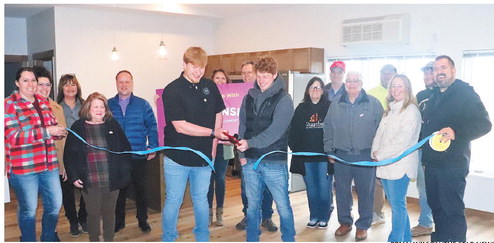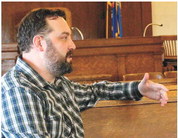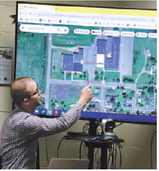Loyal School District shares list of potential cuts if referendum fails
In what Loyal School Board President Tom Odeen referred to as a “crossroads” moment, school district taxpayers will be tasked Tuesday with deciding whether or not to renew the district’s existing operational referendum, which expires this year. The existing referendum allows for a $675,000 revenue cap exemption per year.
The proposed referendum would authorize the district to exceed the revenue limit by $900,000 in 2024; $1.4 million per year in 2025 and 2026; and $1.5 million per year in 2027 and 2028. The money will go toward normal school operational expenses, chiefly maintaining current staffing and programming.
“An operational referendum is exactly what it states, so we can keep our doors open and we can operate. It does not include any capital improvement, so it doesn’t include blacktopping, replacement of sidewalks, building any type of structures, things like that,” said District Administrator Chris Lindner. “We are really looking at our staff salary and benefits, which makes up about 70 percent of our Fund 10 (general fund) budget. Approximately 15 to 20 percent works with maintaining our facilities and then another 10 or so percent is resources for our teachers.”
Some school district voters have asked what the district stands to lose if the referendum does not pass. Last Wednesday, the school district published a list of potential budget cuts on its website. According to that list, the district is looking at the following reductions for the 2023-24 school year, if the referendum fails: eliminating the full-time substitute position, eliminating the kindergarten paraprofessional position and eliminating one food service position.
Other potential reductions include: -- Eliminating all middle and high school non-instructional funded clubs and activities such as FFA; Family, Career and Community Leaders of America, Future Business Leaders of America, Fellowship of Christian Athletes, National Honor Society, Student Council, Spanish Club, Varsity Club, Drama, Forensics and Science Olympiad -- Eliminating school-funded field trips -- Eliminating middle school athletics -- Eliminating paid elementary athletics positions -- Initiating a “pay to play” high school athletic fee -- Reinstating admission fees for all events Potential reductions in terms of staffing include: -- Eliminating one administrative position -- Reducing the co-athletic director to one position -- Reducing elementary and middle school grades to one section based on student enrollment -- Reducing elementary non-state required specials (i.e. computers and library) -- Reducing middle and high school elective courses based on student enrollments (courses such as agriculture, technology education, art, Spanish, business, family/ consumer education, music and physical education) -- Eliminate or reducing non-instructional staff positions, such as clerical workers, instructional technology coordinator, regular education aides, playground supervisor and custodial positions Other potential cuts include deferring maintenance and repairs for the roof, boilers and heating infrastructure; and eliminating individual computers for students.
“One thing that has been brought up is, why don’t we make the cuts? And we are trying to make cuts. And we will make cuts, no matter whether the referendum passes or not, we are looking at everything we have and making it efficient… We will streamline this as much as we possibly can. But, in my opinion, it will never be enough,” said school board member Dennis Roehl in a referendum informational meeting last Wednesday.
“If it does not pass, we are going to have to strip ‘er pretty clean. And I don’t think anybody would like what our school would look like. What we would offer would be very bare bones and I think the kids would suffer greatly if we make severe cuts,” he added.
Mill rate impact If voters approve the operational referendum, taxpayers would see the school portion of their property taxes increase $1.06 per $1,000 of property value in the first year, or $106 per year on a $100,000 home.
The 2022 school tax mill rate is $6.08. The projected mill rates are as follows: $7.14 for 2023, $8.98 for 2024, $7.95 for 2025, $8.06 for 2026 and $7.78 for 2027. The peak of $8.98 in 2024 would still be lower than the district’s mill rate in 2020, which was $9.18.
Please see Referendum, page 7 Referendum,
from p. 1
Loyal currently has a lower mill rate than the majority of surrounding districts. The 2022 mill rates for various area districts are as follows: Abbotsford $8.68, Spencer $8.47, Owen-Withee $7.60, Granton $7.39, Greenwood $7.24, Colby $7.04, Thorp $6.23, Loyal $6.08 and Neillsville $5.07. The average state mill rate for 2022 was $7.68.
Background information In Wisconsin, all school districts operate under a revenue limit created by the state budget. This limit caps the amount of money districts can receive through state aid and local property taxes, the two main sources of funding for school districts.
Wisconsin Act 16 implemented revenue limits for school districts beginning with the 1993-94 school year. Unless the school funding formula changes, school districts are required to go to a referendum if they wish to exceed the state-imposed revenue limit. More than 80 percent of the school districts in Wisconsin have gone to referendum in the past five years. In this area, Granton, Greenwood, Spencer and Owen-Withee are under operational referenda.
Since 2014, the Loyal School District has had an operational referendum to help meet operational costs, with the current revenue cap exemption at $675,000 per year. However, district officials say, rising costs due to inflation along combined with declining enrollment (enrollment dropped by 49 students in the last five years) mean that the current level of $675,000 is no longer sufficient to maintain the current level of school operations and programming.
“So we have the $675,000 going off our budget this year We were hit hard with declining enrollment this year with about 25 students districtwide not in our building, and that is about $250,000. So do the math, you’re talking $1 million. So with our rising costs along with our revenue being status quo, that is why we come to the community and ask for money,” said Lindner, as to why the district was asking for $900,000 in the first year of the referendum.
He also addressed why the referendum amount increases in Year 2.
“There is a jump from the first year to the second year from $900 (thousand) to $1.4 (million). Again, this is declining enrollment. You’re taking that $675,000 off. But this is the worst-case scenario. This is with zero extra money coming. No increases in per-pupil aid, no increases in equalization aid, special ed. aid — so that is really taking that to the very worst; if there is zero increase in the next five years, that is where we’re sitting. Now, the state budget is out there; they’re working on doing some things… But we won’t know anything until maybe a little bit in July but you’re really talking October. So this is the reason why we are asking now,” said Lindner.
“If this passes and we do get more aid, we do not have to tax to the full amount. We will tax to what we need. If it’s Year 2 and we need $1 million instead of $1.4 million, that’s what we tax to, that $1 million.”
Lindner addressed some additional concerns and comments people had made about the referendum.
In the fall capital improvements referendum, a lot of people asked why the district wasn’t doing more to work with neighboring school districts. Lindner said the school district took that feedback into account and that in the last seven or eight months there has been a lot of collaboration with Greenwood. This has included three joint staff in-services; combining events for students, such as the ACT Boot Camp; merging the schedules so in the future, students can be bussed to the other school for classes; and looking into sharing staff for upper-level or elective courses.
Some community members have also questioned why the Loyal and Greenwood districts don’t just consolidate to solve the problem. Lindner acknowledged that was an option, but one that would require careful planning and the community support to get there.
“Mr. (Joe) Green over at Greenwood and myself really, really want to talk about collaboration and start with that. Whether it leads to consolidation down the road, that’s yet to be seen, but I know our two districts have talked a number of times about consolidation the last 60 years and it has not gone anywhere. And the most recent being the early 2000s and it just didn’t go. Both districts voted it down. And this is a process. It’s a three- to five-year process. So that would be something down the road.
“With this referendum, that would maybe make us a little bit closer to where we’re at, where’s our collaborating at in five years and how efficient are we,” he concluded.
Financial implications of referendum failure The district’s fund balance is currently at approximately $1.4 million, which is about 15 percent of the annual operating budget. If the referendum fails, that would last two to three years before the district would be out of money.
“If we don’t receive additional revenue from the state or additional revenue from our residents to support our school, we run out of money. There are no options for us to continue to cut staff or to bring in new money. We can’t do short-term borrowing, because that has to be paid back within the same year and we can’t pay it back within the same year. So we’re going to be in a world of hurt the second year. That’s where it’s really going to affect us,” said board president Tom Odeen.
“The other thing people have to consider is, if we start scaling back our school — reducing staff, reducing programs or electives — where are parents going to want their kids to have their education? I think we can be proud of our school, the offerings that we’ve had, the advanced classes that we’re able to provide students, the hands-on skills that they learn at school, whether they’re going to a technical college or university — I think we can be proud of what our school has done in its history. But we cannot continue to offer some of those things if we don’t have funds to keep things going. And if we aren’t offering those opportunities but our neighboring districts are, it’s going to be a tough choice for parents when asking, ‘Where do I want my kids to be educated?’ Because we all want our school to survive but that’s the reality of it.
“Make the decision for the kids. They’re the ones that are going to hurt if they don’t have the support.”
More information about the referendum, including 25 answered questions, is available on the school district website, loyal.k12.wi.us. Through an online form, users may anonymously submit a question, which the district will do its best to answer within 24 hours, Monday through Friday.
Lindner and the board members encouraged anyone with questions or concerns to reach out to one of the board members or the school district. You can reach Lindner at 715-255-8552 ext. 1300 or chrislindner@loyal.k12.wi.us. Board members’ email addresses are listed on the school website, loyal.k12.wi.us.





